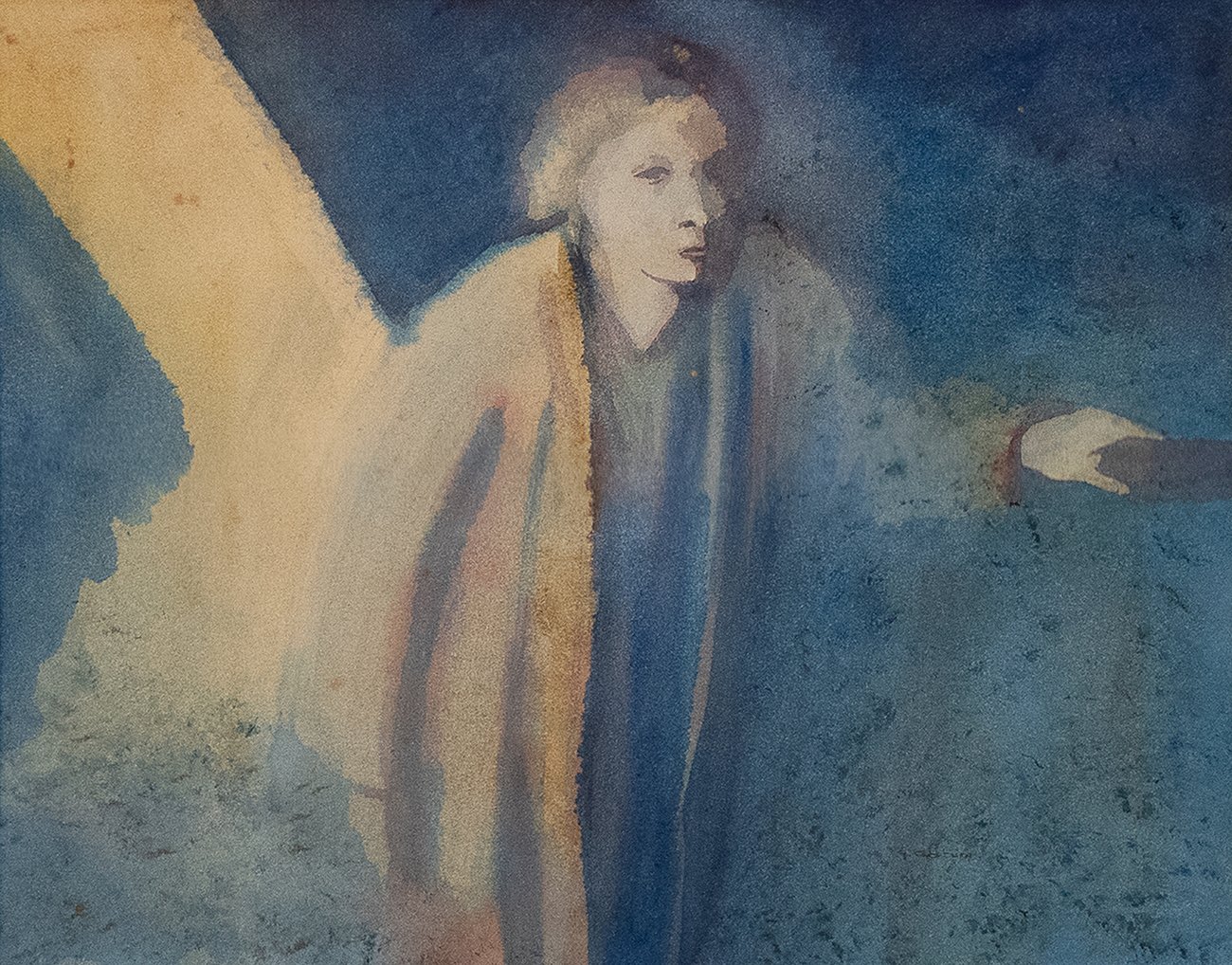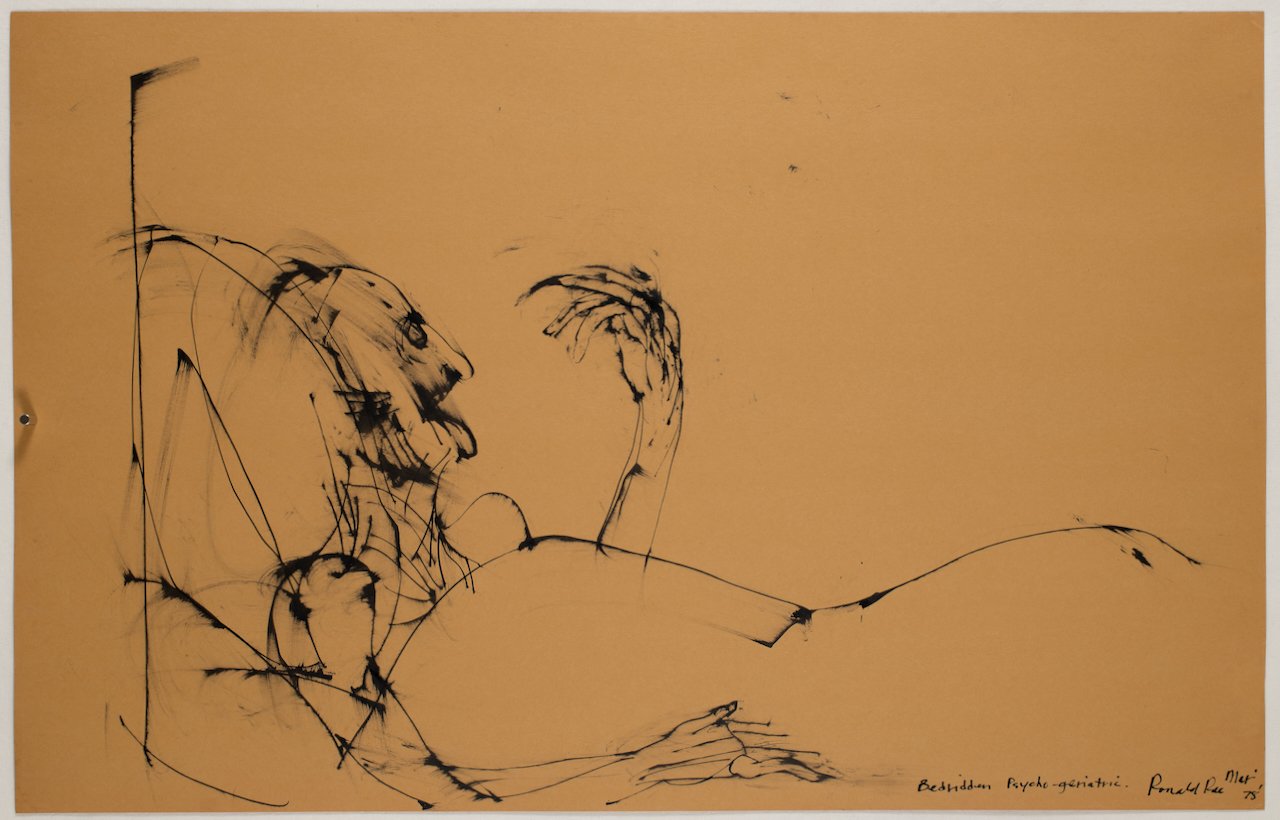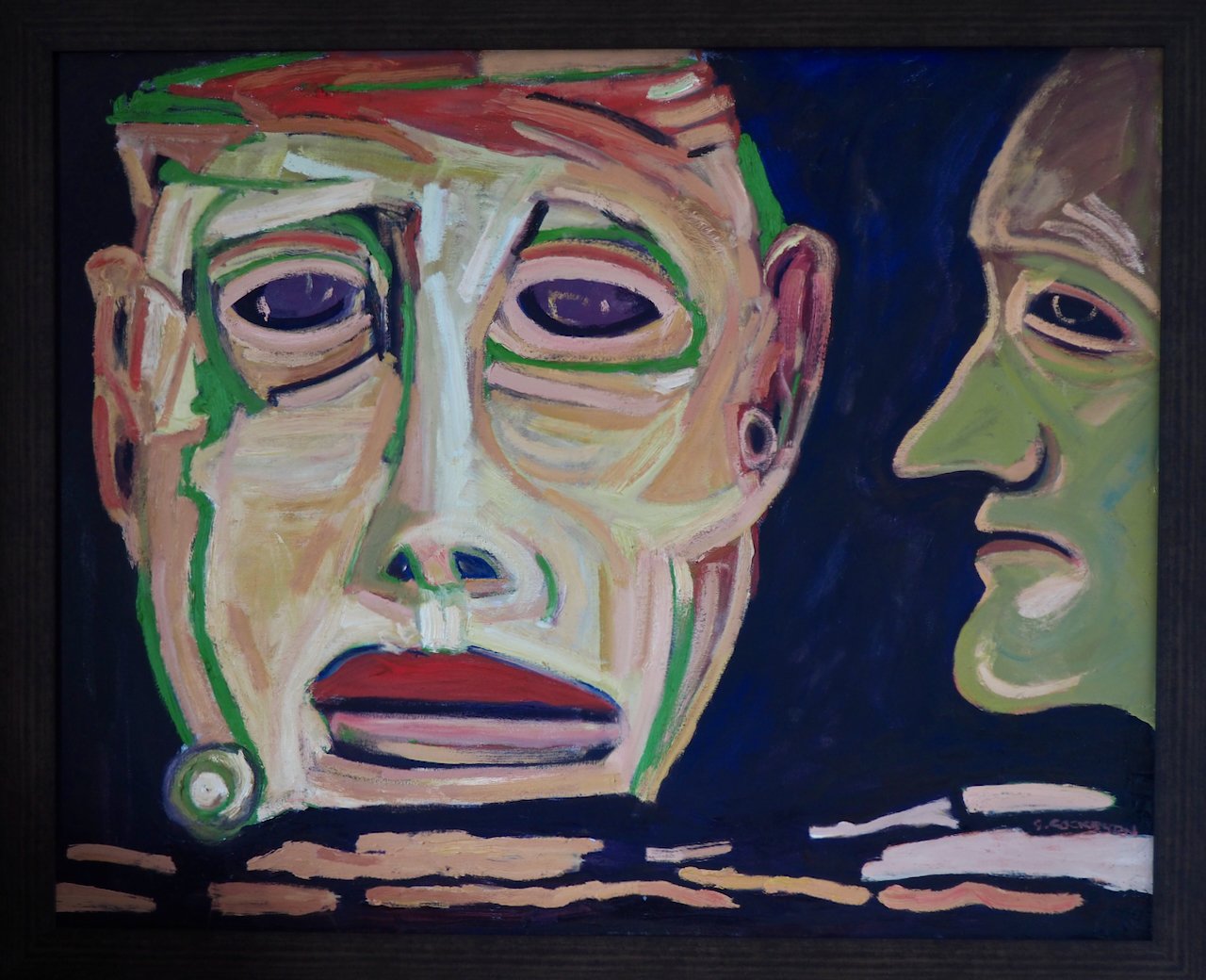
Converge Diverge
Gordon Cockburn and Ronald Rae - a conversation over five decades.
Rozelle Gallery, Ayr 18.11.23 - 28.01.24
Gracefield Arts Centre, Dumfries 10.02.24 – 06.04.24
The Baird Institute, Cumnock 18.05.24 – 31.08.24
Who can identify the exact point at which an interest in the arts flames into life, such that the visual and symbolic language becomes an essential focus for intellectual and aesthetic discovery?
The Converge Diverge exhibition was some years in preparation and at times I seemed to be following in the footsteps of Don Quixote, while developing the concept and realisation of the project. In terms of origins, an interest in collecting was followed by a serendipitous meeting with Ronald Rae and later with Gordon Cockburn. Much later, I realised that there was a story to be told of their friendship, and of their separate development as artists over 50 years or more.
Gordon Cockburn was born in Maybole in 1944 and Ronald Rae in Alloway, in 1946. Both had developed very early interests in art, but whereas Cockburn benefitted from his schooling and the mentoring of Bill Lockhart (the Principal Teacher of Art at Carrick Academy, who had travelled widely and met Picasso), Rae rebelled against formal education and dropped out to follow his own path. The pair met while working at Prestwick Airport in the early 1970’s and struck a bond that lasted until Cockburn’s death in 2022. They convened for fevered expressionist drawing sessions, and after Rae had moved to Edinburgh, they kept up regular phone contact, sharing their knowledge and discoveries.
Cockburn raised a family (a daughter and a son) and had to take on a demanding career in order to make ends meet, but he followed his passion for painting and continuously explored technique and style, developing a heightened palette applied with refined brushwork. Expressionism and Colourist influences are clearly to the fore, with essays into abstraction.
From the early 1990’s, following a visit to Auschwitz, Cockburn became preoccupied with the Holocaust, and developed an extensive series forming up to one third of his extensive oeuvre, without any expectation of reward, for the next 25 years. Although Cockburn had no direct connection with the Holocaust, he felt the horror and pity of the events very keenly, and the validity of his work was endorsed by his friend Cantor Ernest Levy, himself a Holocaust survivor.
Rae developed a fascination for granite from the age of 15, when he found a granite boulder that had rolled away from a drystane dyke, and took it home to carve. He described the spark and smell of burning lichen from the stone as it was struck, this igniting his passion to discover the life within.
Rae self-taught, with the help of the extensively stocked Ayr Carnegie Library, then attended Edinburgh College of Art for one year, before dropping out due to his determination to pursue his own agenda. Following a brief residency in Chicago, and while carving the ‘Tragic Sacrifice of Christ’ (the quintet of large granites in Rozelle Park, Ayr), Rae met his second wife Pauline MacDonald, and they moved to Edinburgh in 1980.
MacDonald ably promoted Rae’s work and they earned a good living from his sculpture. He was later elected to Fellowship of the Royal Society of Sculptors. Rae’s graphic works were shown at Gerber Fine Art in Glasgow, and in 1994 at Sheffield Graves Gallery, but his career as a sculptor was prioritised at this time. One of the confusing effects of an autodidactic mind is that it never rests from experimentation, such that Rae could never be tied down to a single medium or style.
This exhibition aims to sample these styles, although only an impression of his diverse and vast output can be given. In relation to graphic work and found objects, Rae works in a wide range of media, referencing art history and key world events over the last century with immense emotive and spiritual immediacy. He also works on more detailed tableaux full of fantasy and unconscious meaning; one example, his elaboration of H.C. Andersen’s ’Sagor’, was acquired by the National Galleries of Scotland in 2019.
What both artists shared is an instinctive identification with human suffering, and they have made a rigorous and yet instinctive study of experiences of loss, alienation, mental disorder, and war. This is evident through every stage of their working process, starting with the choice of subject; then bringing their own emotional response to life in line, posture, composition, and the language of colour. The transcendent achievement of Cockburn and Rae has been to recover the identities of people who have suffered from social exclusion, illness or disability, and oppression. In this task they have made the unbearable not only tolerable, but dignified and full of the human spirit.
Robert De Mey
An exhibition catalogue has been published and an artist monograph: ‘Ronald Rae, an Inner Life’, published by the Unicorn Group, is on sale through outlets including Waterstones, or at the exhibition galleries.
Converge:Diverge is not a selling exhibition. Any enquiries about the artists’ work should be directed as follows.
Gordon Cockburn :
Ronald Rae :
Compass Gallery
178 West Regent Street
Glasgow
G2 4RL
T : 0141 221 6370
IMAGES
All works are copyright of the artists. Photos are by Robert De Mey unless credited otherwise.
ConvergeDiverge Exhibition Poster, 2023, design © Nye Hughes
Photographic portrait of Gordon Cockburn, 2013 © David Blatchford
Ronald Rae in his Garden, 2023
Gordon Cockburn and Ronald Rae Ronnie Drunk Co-produced Charcoal on paper, 39 x 29cm, 1974
Gordon Cockburn Lady on the Stairs/Aunt Sadie Watercolour, 38 x 48cm, 1967. Photo: Scott Walker.
Gordon Cockburn Trial Portrait no.1 India ink on paper, 52 x 36cm, 1972
This work is likely inspired by William Hogarth’s exploration of all strata of society in 18th Century London. Photo: Scott Walker.
Gordon Cockburn ‘Mirror Image no.2 Pastel on green paper, 64 x 51cm, 1970
This work pre-dates but also predicts Cockburn’s later psychiatric series. Photo: Scott Walker.
Gordon Cockburn Madness no.7, Confinement Ink on paper, 92 x 81cm, 1980
Ronald Rae Bedridden no.2 India ink on paper, 58 x 91cm, 1978
Completed during the artist’s residency to Chicago under the patronage of philanthropist, Morris Bear Squire, who owned psychiatric facilities. Rae engaged with patients at a social level and then drew their portraits from memory. Although at face value this example might be considered intrusive, the detail reveals a very tender portrait of a spiritual state approaching death. Photo: John Glynn.
Ronald Rae Down and Outs no.35 Mixed media on paper, 63 x 89cm, 1980
Rae is thought to have completed one of the longest series on homeless people in art history, comprising over 60 works. He got to know the people of the Grassmarket in Edinburgh at a personal level. Photo: Scott Walker.
Ronald Rae Social Welfare Drawing no.36 Wax on paper, 75 x 49cm, 1983
This work is one of many which Rae created blindfold, a technique which very few artists have used outside of art school. The resulting ragged composition perfectly reflects the active movement of the person enjoying his sandwich. Photo: Scott Walker.
Gordon Cockburn Marcel Marceau: See no evil, Hear no evil, Speak no evil Oil on board, 50 x 76cm, c.1974.
This confident expressionist work inverts the popular saying, the ‘see no evil’ and ‘hear no evil’ figures hiding behind the figure with a glassy emptiness of speech. A metaphor for our times.
Gordon Cockburn Maasai Young Lovers Ink on paper, 46 x 37cm, 1993
This universal expression of love transcends cultures. Photo: Scott Walker.
Gordon Cockburn Miner. Head study with Carbide lamp Oil on board, 24 x 19cm, 2004
Cockburn’s father and grandparents were miners, and he produced an extensive series documenting the life of the miners within the landscape and their communities.
Gordon Cockburn Auschwitz Mother and Child Oil on board, 73 x 73cm. 1993
Part of Cockburn’s extensive Holocaust series, with inventive use of collage and of a classical motif. A short film about the inspiration for the series, created by the artist’s son Daryl Cockburn, will be displayed at the exhibition.
Gordon Cockburn Demon Drinker, Amsterdam Bar Oil on board, 75 x 49cm, 1999
Cockburn deploys a German expressionist style to hallucinatory effect, the only alert customer gazing outwards to invite our response.
Gordon Cockburn Green Figure Compress Mixed media on paper, 27 x 37cm, 2019
Reminiscent of the layered work of Hundertwasser, this late abstract work contains several figures in complex relationship to each other.
Gordon Cockburn The Gaze Oil on canvas, 80 x 100cm, 2020
This work appears to depict a relationship of compassion and dependency. Small areas of unpainted canvas add to its luminescent properties.
Ronald Rae Seated Man Bronze, 58 x 45 x 25mm, c. 1981
This is from an intermittent series of bronze works which are carved and filed. They exaggerate the human form in miniature using a stimulating blend of curve and angle.
Ronald Rae Woebird Dreaming Household paint on board, 430 x 480 x 25mm, c.2003
This textural and layered work conjures the heat of the outback and a transcendent dreamtime, transfixed by eyes of yearning and of doom.
Ronald Rae Burning Doll - Paradise Regained Biro on A4 paper, 1992
This work is as bleak as any from Rae’s pen, and in terms of its intensity and a descent into some private hell, is reminiscent of Paula Rego. Exhibited Graves Art Gallery, 1994.
Ronald Rae Cyril Gerber Fine Art catalogue - Familiar and Unfamiliar Faces, 1997
This relates to an exhibition of a selection of 200 portraits (‘Book of Faces’) Rae had made after seeing people on the London Tube and at the Edinburgh Festival, in 1995. They were all made from Rae’s photographic memory, using biro, on small scraps of paper. Rae was possibly the first artist to use biro as a fine art material (from 1981 onwards), and also the most prolific in this medium. The drawings are displayed at the exhibition with the help of a tablet slideshow.
Ronald Rae, From ‘Illustrations for Unwritten Fairy Tales book 2’. Mixed media on paper (In The Age of Expansion, pub. Thames Hudson 1968), 355 x 550 x 50mm (open book), 2005.
One of 94 drawings, this work subverts any conventional reading of 500 years of Euro-centric history, creating a surreal fable and quixotic exploration of 20th century art and iconography. Refined draughtsmanship and inventiveness underpin the cartoon elements. This drawing presents a surreal tableau of the type encouraged by Louis Aragon, described as ‘quotidien marveilleux’; some elements are mundane; the dog draws our attention to the mythological bull who appears to be reading; perhaps representing an autobiographical element.
Ronald Rae, From the Daily Telegraph series of c.1400 drawings. Chanel No 5 Biro on newspaper, 575x740mm, 2017.
Rae tenderly subverts our aspirational vision of perfection, the model’s smiling eyes preserved in this triple portrait of innocence or threat.
Ronald Rae, From Letters of Faith to myself, one of c.450 drawings in a Victorian family Bible. Biro and collage on paper, 32 x 27 x 10cm, 2020
In this magisterial work containing c.500 pages of inscription and 450 drawings, Rae pours out his grief for the loss of his second wife, Pauline MacDonald in 2019. The work flows in thematic waves, like a musical composition, with a faltering start, capturing tender moments and of memories both harmonic and dissonant. In this drawing, Rae steps out of his bereavement to describe states of dispossession.
Ronald Rae Madonna and Child Mixed media on paper, 59 x 42cm, 2022
Rae admires Andrei Rublev (1360-1420), who has been described as ‘the Russian Giotto’ for his religious ikon paintings. Rae’s work in this style transcends the limitations of flat images, through intensity of expression, handling of colour, and the relational figures. In this work a central strip of the surface paper between the Madonna and the child is torn away to emphasise the division in their state. The infant sheds a tear of blood, as if forecasting his end.


























